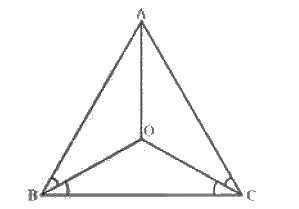Practice-ready answers for Class 9 Chapter 7 Triangles Maths Exercise 7.2: FREE PDF download
NCERT Solutions for Class 9 Maths Chapter 7 Triangles Exercise 7.2
FAQs on NCERT Solutions for Class 9 Maths Chapter 7 Triangles Exercise 7.2
1. What is the main focus of NCERT Solutions for Class 9 Maths Chapter 7 Triangles Exercise 7.2?
NCERT Solutions for Class 9 Maths Chapter 7 Triangles Exercise 7.2 mainly help students practice and master the congruence of triangles and related triangle properties. The exercise emphasizes applying congruence criteria like SSS, SAS, and ASA to solve geometric questions, as per the CBSE 2025–26 curriculum.
2. Which criteria of congruence of triangles should be understood for Exercise 7.2 in Class 9 Maths?
To correctly solve Exercise 7.2, students must understand these congruence criteria as per NCERT guidelines:
- SSS (Side-Side-Side)
- SAS (Side-Angle-Side)
- ASA (Angle-Side-Angle)
- AAS (Angle-Angle-Side)
- RHS (Right angle-Hypotenuse-Side) for right-angled triangles
3. How do NCERT Solutions help students avoid common mistakes while proving triangle congruence?
The NCERT Solutions for Class 9 Maths Chapter 7 guide students with stepwise explanations and clear justification for each congruence statement. They reinforce the importance of identifying matching sides and angles and applying the correct order of steps to prevent logical errors during proofs, according to the CBSE exam pattern.
4. Why is it important to practise problems involving theorems on isosceles triangles in Exercise 7.2?
Practising isosceles triangle theorems, such as "angles opposite to equal sides are equal" and "sides opposite to equal angles are equal", strengthens understanding of triangle properties. These concepts are foundational for competitive exams and higher-level geometry and are heavily weighted in the Class 9 CBSE Board marking scheme.
5. What are the most challenging types of questions students can expect in NCERT Exercise 7.2?
Proving congruence when given minimal direct information, constructing additional lines (like bisectors or altitudes), and using properties of isosceles and equilateral triangles are the challenging parts. Students are tested on how to identify and apply the correct congruence rule based on given and derived information.
6. How does mastering NCERT Solutions for Chapter 7 help with future topics such as trigonometry?
Strong skills in triangle properties and congruence lay the groundwork for future topics like trigonometry, coordinate geometry, and proofs in higher classes, as required by the CBSE syllabus. The logical reasoning and construction skills developed are critical for tackling advanced mathematical concepts.
7. Are students required to know all statements and converses of congruence theorems for Class 9 Chapter 7?
Yes, as per NCERT Solutions guidance for Class 9 Maths Chapter 7, students must understand both statements and converses of congruence and properties theorems. This helps in solving both direct and indirect (reverse reasoning) questions in the exams.
8. What is the difference between SSS and SAS congruence criteria, and how are they used in Exercise 7.2?
SSS criterion requires all three sides of one triangle to match all three sides of another. SAS criterion uses two sides and the included angle between them. In Exercise 7.2, students must distinguish cases where only sides are equal (use SSS) versus when information includes an angle between two given sides (use SAS).
9. Why is justifying each proof step important in the NCERT Solutions for Class 9 Maths Chapter 7?
Justifying every step in a triangle congruence proof demonstrates clear understanding of mathematical logic and is required for full CBSE marks. The NCERT Solutions model this style, encouraging students to reference given data, congruence criteria, and corresponding parts (CPCT) for accuracy.
10. How do theorems covered in Exercise 7.2 support problem-solving in geometry beyond triangles?
Theorems like "angles opposite to equal sides are equal" and congruence tools from Exercise 7.2 help solve parallelogram, quadrilateral, and circle problems by establishing equal sides, angles, or segment lengths, all of which build on triangle properties taught in this exercise.
11. Can you use RHS criterion in questions from NCERT Chapter 7 Exercise 7.2, and when is it applicable?
The RHS congruence rule applies only to right-angled triangles where the hypotenuse and one side are known to be equal. In Exercise 7.2, use RHS only if the problem directly mentions a right angle and specifies the hypotenuse and another corresponding side.
12. What strategies can help tackle conceptual traps in NCERT Solutions for Class 9 Maths Chapter 7 Triangles?
- Always draw neat, labelled diagrams for clarity.
- Carefully identify the given and what is to be proved.
- Explicitly state and justify congruence rule used (SSS, SAS, etc.).
- Avoid assuming data not given in the question.
- Apply CPCT (Corresponding Parts of Congruent Triangles) only after proving two triangles congruent.
13. What should students do if they find a step in the NCERT Solution difficult to understand?
If students face difficulty with any step in the NCERT Solutions for Chapter 7, they should review the relevant congruence criterion and theorem, practice similar examples, and consult their teacher or classmates for clarification, as detailed knowledge is crucial for exams according to the CBSE 2025–26 guidelines.
14. How do NCERT Solutions align with the CBSE marking scheme for geometry proofs in Class 9 exams?
NCERT Solutions follow a strict logic and stepwise format, which directly matches the CBSE Board's marking scheme. Marks are awarded for correct justification, logical sequence, proper diagrams, and accurate conclusion, all of which are modeled in the solutions for Chapter 7 Exercise 7.2.














 Watch Video
Watch Video



























